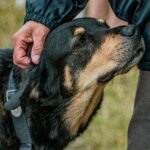As with any breed, understanding and managing their behavior is key to having a happy and healthy relationship with your pet. At three years old, Rottweilers are considered to be adults, and their behavior may start to change as they reach maturity. In this article, we will discuss common behaviors exhibited by 3-year-old Rottweilers and how to address them.
Related Topics:
- Rottweiler Puppy Behavior: Common Problems & Solutions
- Rottweiler Behaviors: Myths vs Facts
- Managing Your 2-Year-Old Rottweiler’s Behavior
Aggression
Many Rottweilers can exhibit aggressive behavior, such as growling, biting, or lunging, especially if they feel threatened or scared. This behavior can be a result of poor socialization or lack of training. To address aggression in your 3-year-old Rottweiler, it is important to consult a professional dog trainer or behaviorist. They can help you identify the cause of the aggression and develop a training plan to address it. Additionally, providing your Rottweiler with plenty of exercise and mental stimulation can also help reduce aggressive behavior.
Separation Anxiety
Separation anxiety can be a common behavior exhibited by 3-year-old Rottweilers, especially if they have been closely bonded to their owners from a young age. This behavior can manifest as destructive chewing, barking, or whining when left alone. To address separation anxiety, it is important to establish a consistent routine for your Rottweiler, including regular exercise and training. Gradually acclimating your Rottweiler to being alone for short periods of time can also help. Providing them with a comfortable and safe space, such as a crate, can also make them feel more secure when left alone.
How much exercise does a 3 year old Rottweiler need?
A 3-year-old Rottweiler is considered to be an adult and will need a moderate amount of exercise to maintain good health and behavior. Rottweilers are a working breed, and they have high energy levels and a strong desire to stay active. Ideally, they should have at least one hour of moderate to high-intensity exercise per day. This can include activities such as walking, running, hiking, or playing fetch. It’s also important to include obedience training and mental stimulation as part of their exercise routine. With proper exercise, a 3-year-old Rottweiler can maintain a healthy weight, improve their overall well-being, and have a happier disposition.
How do you train a 3 year old Rottweiler?
Training a 3-year-old Rottweiler can be a rewarding experience for both you and your pet. At this age, Rottweilers are considered to be adults, and they have a good understanding of basic commands and behaviors. However, it is important to note that every dog is different and the training approach may vary based on the individual’s temperament and learning style.
When training a 3-year-old Rottweiler, it is important to use positive reinforcement techniques. This means rewarding your dog for good behavior, such as giving them a treat or praising them when they obey a command. Consistency is also key, training should be done regularly and frequently.
It’s also important to understand that Rottweilers are working dogs, they have high energy levels and a strong desire to stay active. So, incorporating obedience training with physical exercise is a great way to tire them out and keep them mentally stimulated. In addition, providing them with mental stimulation through interactive toys, puzzle games and training activities can also help to keep them engaged and motivated.
It’s always a good idea to consult with a professional dog trainer if you have any concerns about your Rottweiler’s behavior or if you are not sure about how to train them. A professional trainer can help you develop a training plan tailored to your dog’s specific needs and help you to achieve your training goals.
3 year old rottweiler in human years
A 3-year-old Rottweiler is considered to be an adult in terms of their physical and behavioral development, but when it comes to age in human years, it’s not as simple as a direct conversion. The general rule of thumb is to multiply a dog’s age by seven to estimate their age in human years. However, this method is not entirely accurate as different breeds age differently and also the size of the dog matters.
For Rottweilers, a 3-year-old dog would be considered to be around 21 in human years. This is because large breeds like Rottweilers tend to have shorter lifespans than smaller breeds, and they tend to reach their full physical maturity at a younger age. However, it’s important to note that even at 3 years old, a Rottweiler is still in the prime of their life and has many more years of companionship to offer.
Conclusion
Understanding and managing the behavior of your 3-year-old Rottweiler is crucial for maintaining a happy and healthy relationship with your pet. Common behaviors such as aggression and separation anxiety can be addressed with the help of a professional trainer or behaviorist and a consistent routine that includes regular exercise, training, and mental stimulation. Remember, with patience and persistence, you and your Rottweiler can have a beautiful bond.







